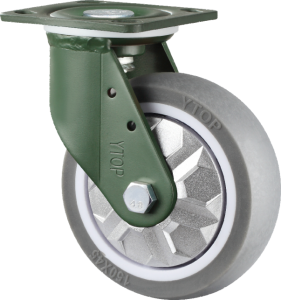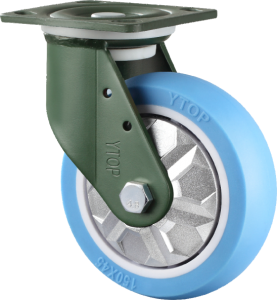Rubber and polyurethane are both common industrial materials, and both are the basic components used to make caster wheel tread material. Both materials have their own advantages and disadvantages, and the following section explores the differences in detail, as well as the circumstances in which you should choose which material.
Let’s start by looking at the physical differences between rubber and polyurethane. Rubber is a round part made of a rubber material that is generally flexible and non-slip. Rubber is mainly categorized into natural rubber and synthetic rubber, and can be adjusted for hardness and abrasion resistance as needed. Polyurethane is generally harder and more abrasion resistant than rubber casters. Polyurethane casters are usually made from polyurethane elastomers, which have a higher density and hardness.
Secondly, rubber casters and polyurethane casters perform differently in different scenarios. Rubber casters perform well in terms of flexibility, anti-slip and sound insulation, and are relatively cheap and easy to process and manufacture. Therefore, rubber casters are a better choice in situations where flexibility and shock absorption are required, such as in medical equipment, furniture, electronic equipment and sports equipment. Polyurethane casters, on the other hand, perform better in terms of hardness, abrasion resistance, and load-bearing capacity, so they are more suitable in industrial, manufacturing, and construction situations where weight bearing is required.
The two kinds of casters are also different in terms of environmental protection. Rubber casters require the use of chemicals in the production process, such as vulcanizing agents and accelerators, which may pollute the environment. Polyurethane casters, on the other hand, are more environmentally friendly as they are a recyclable material and produce less waste during the manufacturing process.
Finally, in terms of price, rubber casters are relatively cheaper while polyurethane casters are relatively more expensive. This is because polyurethane materials are relatively more expensive and more difficult to process, so polyurethane casters are more expensive. Rubber materials, on the other hand, are less expensive and the manufacturing process is simpler, so rubber casters are relatively cheaper.
So, when choosing rubber casters and polyurethane casters, how should you choose?
In fact, both have their own advantages and disadvantages, and the specific choice should depend on the situation. If you need elasticity, anti-slip and shock-absorbing features, such as in furniture, electronic equipment and sports equipment, you should choose rubber casters. If you need casters with greater weight capacity and abrasion resistance, such as in industry, manufacturing and construction, you should choose polyurethane casters.
Apart from rubber casters and polyurethane casters, there are other types of casters such as nylon casters and PP casters. Each type of caster has its own advantages and disadvantages and should be chosen according to the actual needs. In addition, when choosing these casters, you should pay more attention to the thickness of the steel plate of the bracket, the steel plate material, to a large extent, determines the bearing capacity and safety of the casters, should not be ignored, try to choose the manganese steel type of material of the caster, the quality and reliability of which is much higher than ordinary steel.
Of course, should also pay attention to the size of the casters with the installation, to ensure smooth installation, so that its normal operation.
Post time: Mar-04-2024


